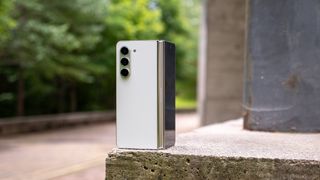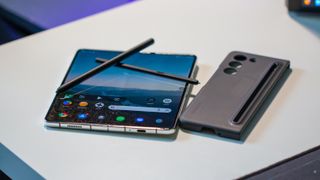Samsung is rumored to solve one of the biggest problems with folding phones
Dust resistance is coming, according to recent leaks

What you need to know
- A massive leak of marketing images and press materials for the Samsung Galaxy Z Fold 6 and Galaxy Z Flip 6 revealed basically everything about the upcoming devices.
- A small but effective change Samsung is rumored to make with its next-gen foldables is dust resistance.
- Foldables have long featured water resistance, but the Galaxy Z Fold 6 and Galaxy Z Flip 6 would be the first U.S. phones to feature both water and dust resistance.
Last week, a massive leak uncovered nearly everything about Samsung’s upcoming foldables — the Galaxy Z Fold 6 and Galaxy Z Flip 6 — which will be officially announced at a Galaxy Unpacked event on July 10. The leak featured official marketing images and press materials, leaving little to the imagination. One change is so small that you might have missed it, and yet it could have the most impact of any change Samsung is making this year.
It’s no secret that folding phones have had a durability problem since day one. Samsung’s first Galaxy Z Fold device broke into the hands of reviewers before the phone became fully available for consumers. Subsequent versions of the Z Fold 2, Z Fold 3, and Z Flip were better but still had serious durability concerns. It wasn’t until the Galaxy Z Flip 4 and Galaxy Z Fold 4 that Samsung seemed to really perfect the folding phone design.
In the beginning, foldables were brittle, lacked water resistance, and featured weak screens. Eventually, Samsung added water resistance with an IPX8 certification on more recent models. Those folding phones still lacked dust resistance, making them susceptible to durability problems over time. It’s not an issue exclusive to Samsung, either. Motorola’s foldables are the only ones in North America to feature dust resistance, but they aren’t water-resistant beyond IPX2, so there’s a trade-off.
If the latest leaks are to be believed, Samsung is about to shake things up by revealing foldables that are both dust-resistant and water-resistant. It reportedly comes with an IP48 rating, which will give it some degree of protection from both dust and water ingress.




IP ratings can be understood by looking at the first and second numbers separately. The first number represents a device’s dust-resistance rating, and the second represents its water-resistance rating. Because prior Galaxy Z Fold and Galaxy Z Flip devices had an IPX8 certification, they didn’t have dust resistance at all. For what it’s worth, the ‘8’ is the highest level of water resistance. This means that a device can withstand being submerged in a few meters of water for at least 30 minutes.
Water resistance is always important on smartphones since they’re with you pretty much all the time. However, on folding phones, dust resistance is arguably the more important IP rating. There are real points of entry for dust and debris due to the hinge mechanism, as well as more moving parts than a traditional smartphone. All it takes is for one piece of dust to get in the hinge or under the display to cause a whole lot of damage.
The rumored IP48 rating featured on the Galaxy Z Fold 6 and Galaxy Z Flip 6 means that large bits of dust won’t interfere with the operation of the phones. It’s not completely dustproof — that would be IP6X — but it’s a considerable improvement. Larger objects, like those 1mm or greater, won’t be able to get into Samsung‘s new folding phones. There is still work to do when it comes to dust resistance, but this IP rating might significantly improve the durability of Samsung foldables.
Get the top Black Friday deals right in your inbox: Sign up now!
Receive the hottest deals and product recommendations alongside the biggest tech news from the Android Central team straight to your inbox!
Why dust resistance is so important

I’m an early adopter of foldables. I’ve used four different folding phones over the years, and three of those I (foolishly) spent my own money on. That’s how I’ve seen firsthand the ways that dust and debris can considerably affect the experience of using a folding phone.
My first foldable was the Samsung Galaxy Z Flip 3, and this was the generation where Samsung almost made folding phones durable. This model year didn’t have many crippling issues at launch, but the problem with foldables is that their durability issues might not show up until a year or two after they’re purchased. That was the case with my Galaxy Z Flip 3. It was fine for the first year, but the built-in screen protector and folding display started to crack right down the middle after a tiny spec of dust got underneath it.
I then upgraded to the Galaxy Z Fold 4, which was a very expensive foldable. Luckily, that smartphone didn’t suffer from the issues that my Z Flip 3 had. It seems to have held up over time, even though it isn’t my daily driver anymore. The same goes for the Motorola Razr+. It had dust protection, and it’s been mostly fine.
My Google Pixel Fold review unit is the next example of how dust can cause problems for foldables. There was so much talk about the Pixel Fold not unfolding completely flat when it first launched. It has turned into something of a debate among users and foldable enthusiasts. The real answer, based on my experience, is that it does unfold completely flat when you first start using it. But all it takes is a few pieces of dust for the Pixel Fold not to unfold flat anymore. About a year after receiving my review unit, the device clearly does not open up fully.
So, after many years and four folding phones, I’m excited that Samsung is making a foldable that is both dust and water-resistant. These problems I’ve listed aren’t something you have to think about while using a slab phone. That’s why, for foldables to grow, it’s a problem that companies like Samsung have to solve.

Brady is a tech journalist covering news at Android Central. He has spent the last two years reporting and commenting on all things related to consumer technology for various publications. Brady graduated from St. John's University in 2023 with a bachelor's degree in journalism. When he isn't experimenting with the latest tech, you can find Brady running or watching sports.